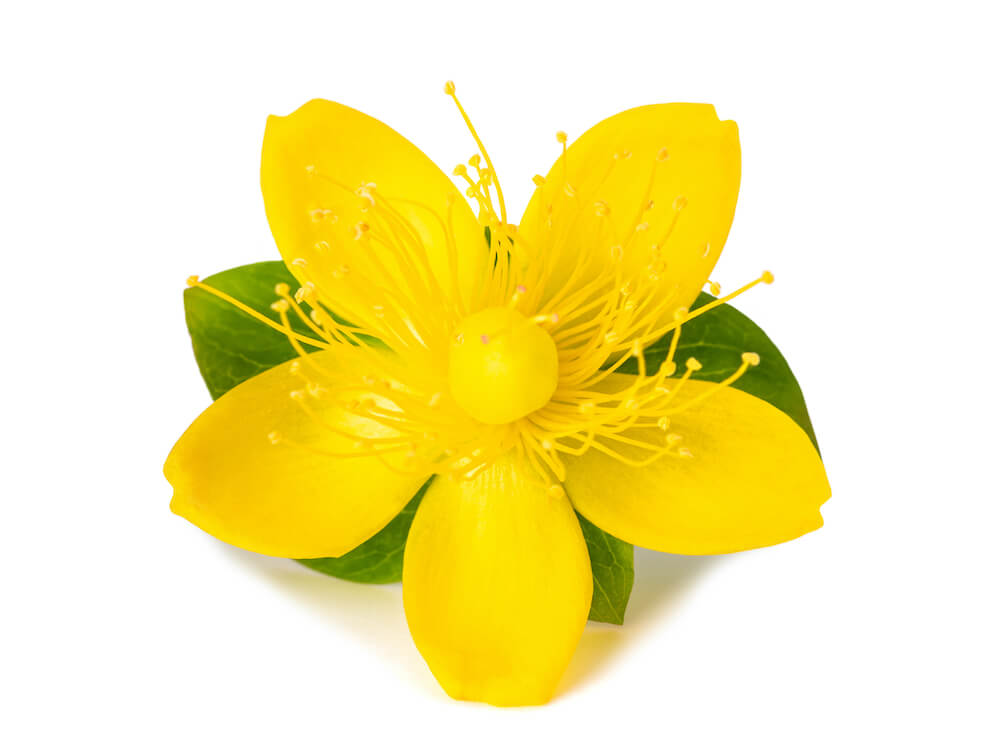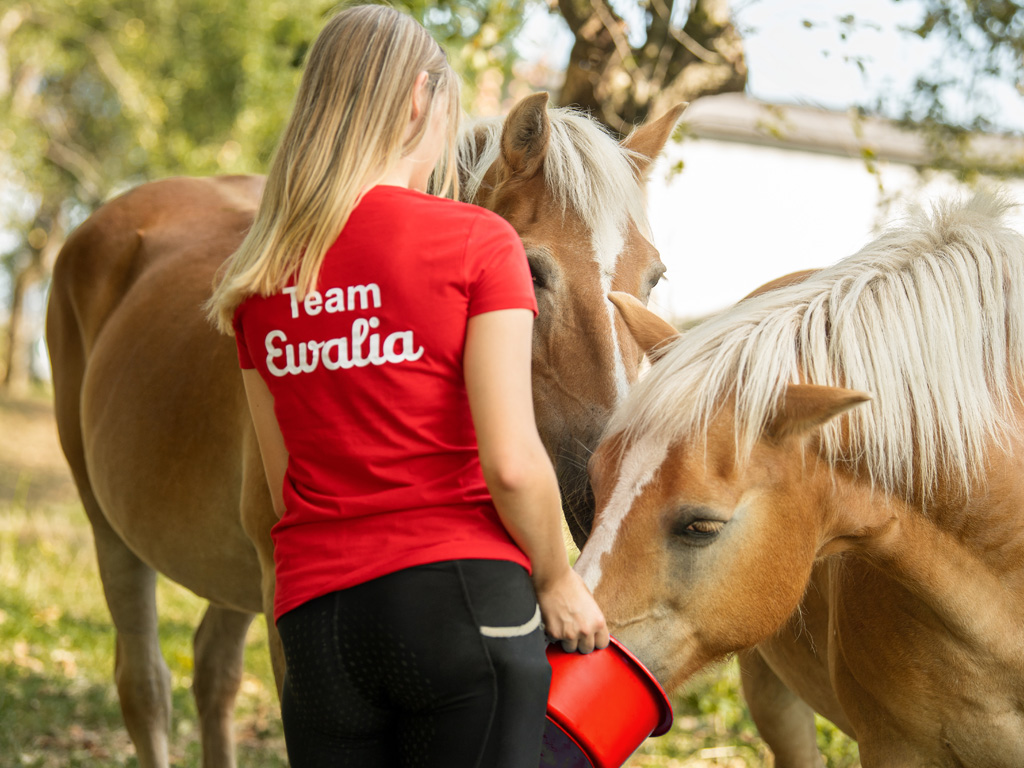Perforate St John's wort

The unique active substances in Hypericum perforatum, aka perforate St John's wort, make this a true feel-good plant. It can lift moods, calm anxious horses and dogs, and contribute to their general well-being.
Where does perforate St John's wort come from, and what does it look like?
Perforate St John's wort is native to the moderate climate zones of Europe. It can grow 50 cm to 1 metre in height on fallow lands, lean meadows, and along the edges of roads and forests.
Its smooth, long, oblong leaves are 2–4 cm long with noticeable dark dots. These dots store the essential oil that the plant produces through glands in the leaves. The stem of the plant is filled with pith, which makes it distinguishable from other Hypericum species. The upper part of the stem is branched, giving the plant a bushy appearance.
As the name suggests, perforate St John's wort begins to flower around St. John's Day and the summer solstice, and its flowering period lasts until August. With their somewhat asymmetrically arranged petals, the open yellow-gold flowers resemble small pinwheels joined together in umbels. Perforate St John's wort flowers have reddish oil glands that contain the intensely coloured substance hypericin. If you use your fingers to crush one of the buds, they will turn red.
After flowering, the ovaries develop into longitudinally dehiscent capsules that are about 10 mm in size. The seeds inside are spread by animals or the wind.
The plant can also be propagated by root cuttings. The long, branched root extends up to 60 cm deep into the soil, which allows the plant to tolerate heat and drought well.
What is perforate St John's wort used for?
The medicinal properties of St John's wort have been known since ancient times. The plant had special significance for wound healing, as inferred from the old name "amber touch and heal". The leaves were dried and crushed before being applied to slow-to-heal wounds and festering sores. Boiled in red wine, St John's wort was used as a stomach compress for digestive complaints. In older books on natural medicine, one finds mostly formulas for schnapps and wine which were taken internally and externally and which were said to relieve a large number of ailments ranging from kidney stones to "stupidity" (Herbal of Pietro Andrea Mattioli, 16th century).
Today, perforate St John's wort is primarily used to relieve mild depression, stress, insomnia, nervousness and anxiety. The relaxing effects of perforate St John's wort preparations can also be effective for nervous heart ailments and gastrointestinal problems. Substances in perforate St John's wort that promote blood circulation can have a supportive effect on circulatory problems.
For perforate St John's wort preparations, the whole herb is harvested in the flowering season in June and July to be dried and processed into tea, tinctures, drops or capsules.
Perforate St John's wort oil for external application is obtained through maceration: the flowers are placed in olive oil and allowed to steep for two months. When finished oil has an intensive red colour. It is traditionally used to treat scars, nerve pain, and blunt injuries.
What makes perforate St John's wort so effective?
The flowers and the leaves contain the red-dye substance hypericin which is found exclusively in perforate St John's wort. Hypericin has antiviral properties, and the mood-lifting effect of Saint-John's-wort is attributed to this substance.
The substance hyperforin, found in the herb and flowers of perforate St John's wort, has antibacterial effects and also blocks germs that are resistant to penicillin. In laboratory testing, for example, this substance proved effective against Staphylococcus aureus. Studies show hyperforin to be responsible for the herb's antidepressant effects. Even very low doses of it can relieve anxiety. It is also thought to improve concentration and memory, independent of its antidepressant effects.
The tannins in perforate St John's wort have positive effects on gastrointestinal ailments. In oils containing the herb, they promote the healing of wounds.
The flavonoids (secondary plant substances) in perforate St John's wort have anti-inflammatory circulation-promoting properties and have strengthening effects on the heart and the circulatory system.
The essential effectiveness of perforate St John's wort as an antidepressant comes from the combination of the flavonoid rutin with the substances hyperforin and hypericin. These plant substances gently and sustainably regulate the balance of neurotransmitters in the brain. They promote inner calm, relaxation, and restful sleep. Perforate St John's wort also contains butyric acid, which is what gives hops their calming effects.
What can perforate St John's wort be used to treat in horses and dogs?
In dogs and horses, perforate St John's wort can increase well-being through its relaxing and gently calming effects.
Cardiac insufficiency often leads to behavioural changes in horses and dogs. Horses that don't feel fit over longer periods become unsure, nervous, and easily spooked. Dogs with cardiovascular problems sometimes exhibit restlessness, especially at night. In combination with hawthorn, ginkgo and maca root, perforate St John's wort can
increase heart health, support circulation and help restless horses and dogs to relax.
In senior horses and dogs who become insecure or withdraw due to physical limitations such as an ageing heart or arthrosis, perforate St John's wort can help relieve anxiety and lift moods, thus contributing to a better quality of life.
Adverse effects:
Perforate St John's wort can lead to the skin developing sensitivity to light (photosensitisation) in animals with light skin pigmentation. In animals with light skin and thin hair, ingestion of perforate St John's wort may lead to itching, blistering and inflammation after prolonged exposure to the sun. Photosensitisation is, however, mostly seen as a result of ingesting very high amounts. Do not exceed the recommended dosages!
Sources and further reading
- Brendieck-Worm, C., & Melzig, M. F. (2018). Phytotherapie in der Tiermedizin. Stuttgart: Georg Thieme Verlag KG.
- DAZ.online. (25. 02 2001). Von Phytopharmaka: Wie Johanniskraut wirkt: https://www.deutsche-apotheker-zeitung.de/daz-az/2001/daz-9-2001/uid-331 abgerufen
- Ganz, C. (2015). Schweizerische Zeitschrift für Ganzheitsmedizin. Von Arzneipflanze des Jahre 2015: Johanniskraut: https://www.karger.com/Article/FullText/371604 abgerufen
- Reichling, J., Gachnian-Mirtscheva, R., Frater-Schröder, M., Di Carlo, A., & Widmaier, W. (2008). Heilpflanzenkunde für die Veterinärpraxis. Berlin-Heidelberg: Springer Medizin Verlag.













